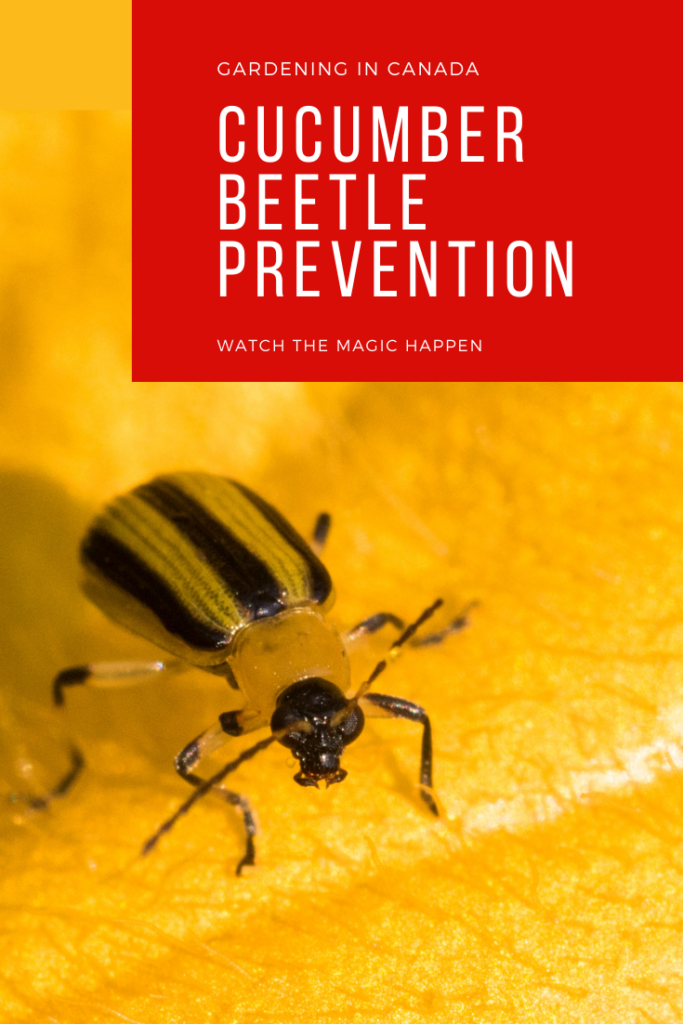- Canada’s Growing Zones Are Changing 2024 - January 12, 2024
- Attracting Wildlife To The Garden - May 16, 2023
- How To Garden Near A Septic Tank - May 9, 2023
Cucumber bugs, a common garden pest, severely injure the plants in the cucurbit family, which includes melon, cucumber, and other plants. These tiny, black and yellow striped beetles eat fruit, flowers, and leaves; they also leave holes in the ground and wilted plants in their wake. Infections like bacterial wilt and others that can kill plants or significantly reduce yield can also be spread by them.
If you are new to this blog my name is Ashley and I am a soil scientist. I am located in a Canadian Zone 3 and a USDA Zone 4. I write articles, make YouTube videos, Instagram & Facebook posts all designed for Canadians and Cold Climate gardeners using science-based methods. If you are looking for anything specific be sure to let me know in the comments down below.
Cucumber Beetle Prevention
To prevent cucumber beetles from infiltrating your garden, use cultural precautions. This entails rotating the crops, planting resistant varieties, and removing crop waste in order to prevent the beetles from overwintering in the garden. Use companion planting to grow plants that can keep insects away, such as radishes, nasturtiums, and tansies. The use of floating row coverings is an essential extra measure for protecting the plants from pests.
Chemical Treatments
In addition to cultural methods, there are a number of chemical techniques for managing cucumber beetles. Neem oil, pyrethrin, and spinosad are effective garden pest control agents that are also widely regarded as secure. It is essential to use the products as recommended and follow the instructions on the label in order to safeguard beneficial insects and other non-target animals.
Another management technique is to employ pheromone traps to capture adult beetles before they lay eggs. By combining traps and insecticides, you could significantly reduce the population.
As soon as you notice drooping, discoloration, or other disease symptoms on your cucumber plants, it’s crucial to remove and destroy affected plants in order to limit the spread of bacterial wilt and other infections.
Biological Treatments
Techniques for controlling cucumber beetles that have been shown to be effective biologically.
One tactic is to use parasites and predators. The tachinid fly Trichopoda pennipes and the braconid wasp Diabrotica balteata are two examples of top-notch natural cucumber beetle predators. These insects can be purchased and disseminated in gardens in order to lower cucumber beetle populations. The nematode Steinernema carpocapsae and the fungus Beauveria bassiana have also been shown to be effective against cucumber pests.
Biological control strategies can be a fantastic addition to an integrated pest management programme in order to handle cucumber beetles. These methods can reduce the need for chemical insecticides and offer a more effective, ecologically friendly method of managing pests. The effectiveness of these methods must be carefully evaluated, though, as the results may vary depending on the specific pests and growth conditions in your garden.
Trap Crops
Growing certain plants known as “trap crops” is another method for keeping cucumber pests away from the main crop. The bugs become stuck on these plants and are simpler to control. Some crops that can be used as traps for western spotted cucumber insects are pumpkins, striped cucumber bugs, and sweet corn.
When the trap crop is fully infested you will want to burn it to avoid the beetles multiplying. A tiger torch works great for this.
In summary:
- A common pest known as cucumber beetles can seriously harm plants in the cucurbit family, including cucumber, melon, and other cucurbit-related species.
- Cultural management, such as crop rotation, the use of floating row coverings, the planting of resistant types, the removal of agricultural detritus, and companion planting are some preventative strategies.
- Cucumber beetles can be successfully controlled by chemical methods such Neem oil, pyrethrin, spinosad, and pheromone traps, but they must be used according to instructions.
- To stop the spread of bacterial wilt and other illnesses, uproot and destroy any infected cucumber plants as soon as you see symptoms of disease.
- Utilizing predators and parasites, such as the tachinid fly Trichopoda pennipes and the braconid wasp Diabrotica balteata, is reported to be an efficient method of controlling cucumber beetles in their natural habitat.
- Cucumber beetles can be controlled by the nematode Steinernema carpocapsae and the fungus Beauveria bassiana.
- In order to lure and trap pests away from the primary crop, trap crops like pumpkins, sweet corn, and striped cucumber beetles can be used.

